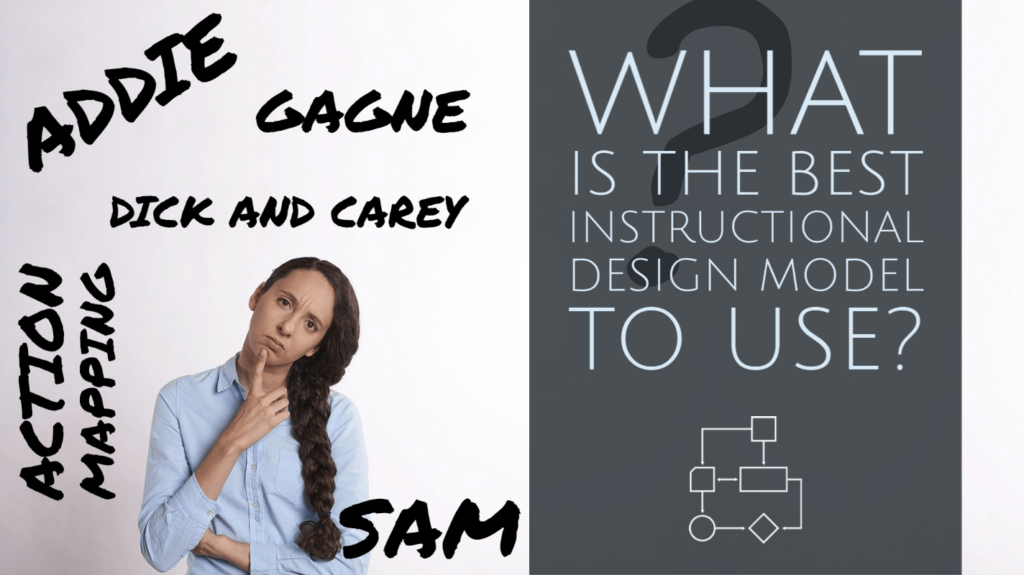If you are getting started with instructional design, you have probably come across several of the instructional design models. ADDIE, SAM, Action Mapping, Dick and Carey, Bloom’s Taxonomy, Gagne’s Nine Events of Instruction… to name a few… As you read about each one, you may wonder “which one should I use?” or “which instructional design model is the best?”
It basically boils down to these three:
- Which one does your class/course use?
- Which one does your company use?
- Which one do you like to use?
I know that may seem a bit glib but I can tell you that in most corporate environments (that’s what I can speak to) nobody except you is going to care about which one you use. That’s not to say you shouldn’t use one. Each model has benefits and if you are serious about working in the field, you’ll want to get familiar with at least a couple of these. Do you need to be an expert in every one? No, you don’t.
Most articles I see on this are pretty high falutin’ and go into a bunch of detail about each model without really giving any real life examples or context. Or they do a brief summary of a whole bunch of them. That’s fine and can be a good way to start learning the differences. What I want to do here is give a very real world view of the ones I actually use and why.
What is Your class or course using?
The first formal instructional design class I took was about 20 years ago and it was through Langevin Learning Services. It was the Instructional Design for New Designers course and it was a live workshop. Prior to that, I was basically just dumping content into a PowerPoint and calling it training. (Kind of like what many people still do now…) I will say that having been a training facilitator and trainer for several years prior, I did at least have an awareness of adult learning and knew to include activities and engagement throughout. So, my crappy training courses were still better than the typical crappy training course. Even so, I had a lot to learn.
Langevin teaches “Langevin’s 12-Step Design Cycle” which looks a lot like ADDIE. I don’t know how much has changed since I took the class 20 years ago but I think that’s basically what was taught then as well. And that’s not a bad thing. ADDIE is an easy to understand way to explain the instructional design process. It’s also the one you are going to see listed in a lot of job posts. I’m not going to detail ADDIE here because there is plenty enough about it out there already. Suffice it to say, it is still used and it still works.
I don’t remember all of the details of the course but I do remember spending a good amount of time on task analysis. That’s where you define a task that you want the learner to be able to do and then you analyze what the training would need to include so that they can do it. For me, task analysis can be a little tedious. At the same time, it was definitely something I needed to understand even if I don’t do a formal task analysis every single time I create training.
Task analysis was also a primary topic in my Masters program. In that program we used the Dick and Carey model which also has a lot of ADDIE elements to it. It’s not as much of a linear approach, though, and is a bit cumbersome in my opinion. Even so, I did find benefit in working through the entire Dick and Carey model as it built on my overall foundation in instructional design.
Neither one of these models (Langevin 12 Step or Dick and Carey) is my “go to” when working on real world projects now (though I do still use concepts and elements from both). I used them in the classes because that was the requirement. If I wanted to “pass” or get a good grade, I needed to use these models. Similarly, if/when you attend an instructional design course, it is likely that your instructor or professor will have you use a particular model. If you find that the model they introduce to you really speaks to you and you end up using it throughout your career, great. If you find it doesn’t fit your preferred working style, that’s ok too. Like I said, I’m not a huge fan of Dick and Carey but I am glad that I got a chance to learn about it and use it.
What does your company use?
I have been doing instructional design in some capacity for the past 20 years or so. I have worked for 8 companies during that time ranging from a small non-profit to behemoths like IBM. While a couple of them had some loose guidelines around which models to use (usually ADDIE), I have mostly been able to use the approach that best suits me and the project I am working on. Oftentimes, that is ADDIE which is a great tried and true approach. Other times it may be a combination of approaches.
Some companies or departments may have more stringent guidelines about which approach to take. For example, if you are part of a large team of instructional designers, there will likely be a more defined process in place. This makes sense for the sake of consistency. When you are THE instructional designer, you usually have a bit more autonomy.
Both situations have their advantages and disadvantages. On the one hand, it’s nice to be the “expert” yourself and choose your approach. On the other hand, it can be nice to not have to think about that and follow a proven process with existing templates and examples.
Similar to the class approach I mentioned above, if your company does expect you to use a particular model, then that’s the one you’ll likely use. Now, does that mean you can’t use any other piece of any other model? Of course not! Even if there is a preferred design model in place, that doesn’t mean you are “locked” into only that model and can’t use other techniques. As long as you are creating quality work that is meeting your company’s objectives, you aren’t likely to get in trouble for adding to your ID process toolbox.
Which one works for you?
This is the real question you should be asking. Which model or models work best for you? Which ones give you the guidance you need while allowing you to do your best work? You probably won’t know that right off the bat. That’s why it’s good to try different models. That’s where a course or company policy could help. You, of course, are also free to experiment outside of those. That’s basically what I have done my entire career.
When you complete a training course for a customer, whether external or internal, do you know how many will ask you “say, what ISD model did you use?” Approximately 0.0. They just want quality training that gets the results they are after. (Or they want to be able to check a box that training was provided…but that’s a whole other article…) At the end of the day, it’s what best matches you and your style. That could be one or more of the “popular” ones or some combination thereof.
So, which one works for me? My favorite and my go to is Action Mapping. I discovered Action Mapping some time around 2010/2011. It spoke to me. I like how it right away focuses on what people need to DO and I really like Cathy Moore’s style and sense of humor in explaining and presenting it. Does that mean it will be YOUR favorite? No. But that’s ok. There are plenty of others out there for you to try!
Want to Learn More?
Here are some books to check out if you want to dive into some more detail around the various models. (Contains affiliate links)
Also, check out my Career Spotlight on How to Become an Instructional Designer.


Pingback: Insider's Guide to Answering Instructional Design Interview Questions - Your Learning Career